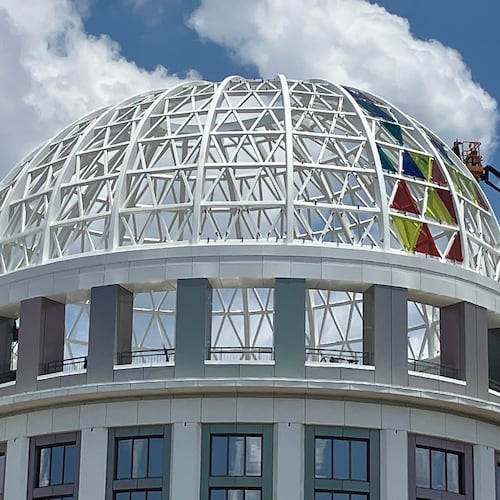Billy Graham, who died Wednesday at the age of 99, was known for many things: His role as presidential counselor and confidant, a reliable comforter of the nation during times of tragedy and the founder and longtime head of a sprawling North Carolina-based evangelical outreach and media nonprofit organization.
But perhaps nothing was more identified with Graham than the “crusades” that first put him in the public eye in 1947 and kept him there for the next six decades. These massive preaching and revival meetings would alight in a major city, for days or even weeks, and bring together thousands of people to hear Graham preach about faith, hope, and, if they hadn’t already accepted Jesus Christ as their personal Savior, becoming “born again.”
They always concluded the same way: With Graham inviting attendees to come forward and commit themselves to live as faithful Christians.
Graham conducted 417 crusades in all, in locations ranging from Aarhus, Denmark to Zurich, Switzerland (see the complete list here). He held four crusades in Georgia, which, along with a separate large evangelistic gathering he organized in Americus in 1966 with the help of then state Sen. Jimmy Carter, took on outsized significance for his work and the country as a whole.
Here’s what you need to know about the Billy Graham Crusades:
In the beginning: In the mid-1940s, Graham started out preaching at Youth for Christ rallies organized by a radio evangelist and religious bookstore owner in and around Minneapolis. In 1947, he expanded his focus into his first citywide crusade at the Civic Auditorium in Grand Rapids, Mich. Lasting for nine days, it attracted some 6,000 people.
Getting his big media break: In 1949, Graham went to Los Angeles for a three-week so-called "canvas crusade" -- the events were held in a large tent downtown. The charismatic young preacher was already getting some press attention when then-newspaper baron William Randolph Hearst took notice. Attracted by the anti-communism message that was part of Graham's preaching, the all-powerful Hearst (who was the model for Orson Welles's mogul in "Citizen Kane") reportedly ordered his newspapers to "Puff Graham." In other words, give him lots of good coverage. The evangelist himself credited Hearst with significantly boosting his profile in a way that led other major newspapers and magazines like Time and Newsweek to follow: "Suddenly, what a clergyman was saying was in the headlines everywhere, and so was the box score of commitments to Christ each night," Graham recalled.
By the numbers: From 1947 to 2005, when he held his last and only crusade that year in New York City, Graham conducted 417 crusades in 185 countries and territories on six continents. During those 58 years, he reached an estimated 215 million people in person or via satellite feeds, according to the Billy Graham Evangelistic Association. Nearly every crusade lasted multiple days, with the longest running one taking place for 16 weeks at Madison Square Garden in New York City and drawing more than two million people. According to a New York Times account, he shared the lessons of Sodom and Gomorrah from the Bible, substituting "New York" for the names of the cities of sin. That 1957 event also marked the first time a Billy Graham Crusade was televised live by ABC. The most heavily-attended crusade took place over five days in 1973 in Seoul, South Korea: Over three million people took part, including an estimated 1.1 million on the final day. It was the single event largest crowd at a Graham crusade.
Credit: HKS Architechs and Georgia State University Special Collections Department
Credit: HKS Architechs and Georgia State University Special Collections Department
When Graham came to Georgia: The Billy Graham Crusade first came to Augusta in 1948. That was followed by three crusades in Atlanta, in 1950, 1973 and 1994. The first Atlanta revival took place over six weeks at Ponce de Leon Ballpark, which was then home to the minor-league Atlanta Crackers (the site, now home to the Midtown Place shopping plaza, sits across the street from Ponce City Market and is overlooked by the Eastside trail of the Atlanta Beltline). Opening day, on Oct. 29, 1950, drew some 25,000 people, at the time the largest crowd to ever hear Graham preach.
Why those Georgia stops mattered so much: Beyond the record setting audience, that 1950 Atlanta stop also was significant in terms of how it convinced Graham to act in ways that helped his ministry avoid financial scandals that would plague some other well known evangelists. In a 1992 interview with Atlanta Journal-Constitution reporter Gayle White, the famed evangelist recalled seeing a newspaper picture of him grinning beside another photo of ushers handling bags of money from services in the old Ponce de Leon ballpark. "I said 'That'll never happen again,' " he said in the interview. "From that time," White wrote, "he says he never accepted another "love offering," a common practice for evangelists. He collected a board of businessmen- advisers and put himself and his staff on salary."
In 1973 the Billy Graham Crusade returned to the city for six nights at Atlanta-Fulton County Stadium. Graham’s refusal to speak up in support of the 1972 Supreme Court decision banning capital punishment led to picketing and some civil rights leaders urging African Americans to skip the event. Yet the Rev. Martin Luther King Sr., father of the slain civil rights leader, led a prayer one night at the crusade.
Race had already been a major issue when Graham came to Georgia a few years earlier. A 1966 attempt by Graham to organize an evangelistic outreach program in Americus initially seemed stymied when members of the community objected to his insistance that the meetings be integrated. With local churches refusing even to host an integrated film screening, Jimmy Carter stepped up. The state senator from nearby Plains and himself a self-professed evangelical, Carter organized the event in the basement of an abandoned school building.
About the Author
Keep Reading
The Latest
Featured




